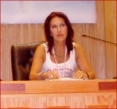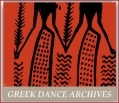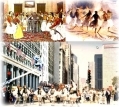|
| |
| |
 |
|
| The Dance Phenomenon and Social Reality - Ass. Prof Anna Lydaki |
| |
| The Dance Phenomenon and Social Reality
Methods of Research
Anna Lydaki, assistant professor
at the Sociology Department of the
Panteion University of Social and Political Sciences
Introduction
Condillac calls the expression of dance factual language and writes that this language was evidently preserved, even after phonetic-verbal expression was created, in order to notify people about topics of prime importance related to law or religion. |
|
| read more |
|
|
| |
 |
|
| FOLK DANCES AND GLOBALIZATION- Prof. Dr. Neoklis Sarris / GREECE |
| |
| I will start with a common aphorism so that I can conclude with a common observation as well. This aphorism is about technology as a human product, and the observation is that, within the last century, a radical and fundamental change took place in human societies through technology, which further evolved them into a uniform type: There are those who want to present this type as the ideal type representing what they call "globalization". |
|
| read more |
|
|
| |
 |
|
| MUSIC IN CINEMA AS A NATIONAL AND CULTURAL IDENTITY- Dr Renata Dalianoudi |
| |
| MUSIC IN CINEMA AS A NATIONAL AND
CULTURAL IDENTITY
Dr Renata Dalianoudi
PhD. Ethnomusicology
(slide 2)
Since music in cinema started to serve aesthetical needs of a film and not just be one among other elements of the film projection (as it used to happen in the mute cinema and in the first steps of the speaking cinema), in other words since 1930, music has become an essential and inseparable component of a movie. |
|
| read more |
|
|
| |
 |
|
| GREEK FOLK MUSIC: FROM YESTERDAY TO THE PRESENT – Á ÌUSICOLOGICAL, ETHNOLOGICAL AND AESTHETICAL APPROACH |
| |
| A synoptic ethnographical presentation of the Greek folk music from the South to the North (from the island of Crete to Macedonia) and from the East to the West (from the Ionian islands to the north Aegean islands) proves that the Greek folk/ traditional music has a variety of rhythms, melodies, dancing forms/ formulas, musical instruments, poetic lyrics, metric, morphological types and structures, strophic schemes etc.
A typical characteristic of the Greek traditional music is its three-part cultural identity: it is consisted of music, lyrics and dance, elements which -since the very Antiquity- were a solid and inseparable unity.
|
|
| read more |
|
|
| |
 |
|
| NIKOS XYLOURIS -ONLY IN GREEK |
| |
| NIKOS XYLOURIS -ONLY IN GREEK |
|
| read more |
|
|
| |
 |
|
| National Orchestras of Siberia: The Past and the Present |
| |
| In 1920s the government of the Soviet Union declared the beginning of a cultural revolution in the country. Its primary goals were: liquidation of illiteracy of the population, citizens’ familiarization with the achievements of world culture, and maximum development of creative abilities in each person. PROF. VICTOR KITOV |
|
| read more |
|
|
| |
 |
|
| Scientific Research in the Field of Folklore within Globalization and Integration Processes- Dr Oksana Mykytenko |
| |
| Scientific Research in the Field of Folklore within Globalization and Integration Processes
A Ukrainian magazine «Vsesvit» interviewed a famous public and cultural figure in Japan Daisaku Ikeda.- Dr Oksana Mykytenko |
|
| read more |
|
|
| |
|
| |
 |
|
| Continuity and Change of Ethnicities and Cultures in New Jersey, U.S.A - Dr Iveta Pirgova |
| |
| 1. Introduction
This paper does not provide an in-depth analysis of the communities and cultures in New Jersey, but it rather suggests an overview of their very complex character as well as an approach for better understanding the continuity and change of each culture as shaped by its long-lasting co-existence in multi-ethnic and multi-cultural context.
|
|
| read more |
|
|
| |
 |
|
| Relations Between the Leading Dancer and the Co-Dancers in Neo-Hellenic Dance -Dr. Ánna Panagiotopoulou |
| |
| Introduction
To make this paper fully comprehensible, the terms used must first be explained.
By the term "Neo-Hellenic Dance" we mean the dance phenomenon of Greece, which is also known as Greek traditional dance.
|
|
| read more |
|
|
| |
 |
|
| Prof. Charles Nyakiti Orawo. Cultural changes and Maintenance of Traditional Values |
| |
| Introduction-
Thum as known today is amorphous in that its corpus has been broadened to include not only the Luo lyre, but also the fiddle, the accordion and the guitar musics unlike what it stood for before the coming of Europeans into the Luo territory. The art of thum tradition consists of solo vocal performance by jathum, the instrument player accompanied on his instrument most often with a chorus who may or may not be involved with other instrumental accompaniments. Whatever the case, the other instrumental accompaniments would be subordinate to that played by jathum. |
|
| read more |
|
|
| |
 |
|
| DANCE DURING THE TRANSITION FROM THE RURAL TO THE URBAN ENVIRONMENT AND TO THE CYBERSPACE |
| |
| In the age of the Internet and Universalism, a simple click on our computer is all it takes to bridge the distance that separates us from all the information that is relevant to dancing and contact with the bodies that provide it. |
|
| read more |
|
|
| |
 |
|
| DANCES OF MOLISTA- EPIRUS REGION |
| |
| ONLY IN GREEK |
|
| read more |
|
|
| |
 |
|
| The Role of Dance in the Formation of Ethnic Identityamong Diaspora Greeks. A Case Study from Australia |
| |
| The Role of Dance in the Formation of Ethnic Identityamong Diaspora Greeks. A Case Study from Australia- This paper explores the hypothesis that ethnic identity among Greek Australians is expressed and transmitted in practical ways and in ritual contexts, especially through traditional dances.
Dr. Vassiliki Chryssanthopoulou |
|
| read more |
|
|
| |
 |
|
| ARTICLE ONLY IN GREEK |
| |
| ARTICLE ONLY IN GREEK |
|
| read more |
|
|
| |
 |
|
| CAN ONE CROSSBREED AN ORANGE WITH AN APPLE ? - Professor Anna Brzozowska-Krajka |
| |
| Can one crossbreed an orange with an apple?Intermarriage and ethnicity in American multicultural metropolis
(In view of the movie My Big Fat Greek Wedding)
Professor: Anna Brzozowska-Krajka
Department of Polish, Maria Curie-Skłodowska University-
Lublin, Poland-
(In view of the movie My Big Fat Greek Wedding)
In American social structure ethnicity refers not to the dominant native host society (summarized as WASP, i.e. White Anglo-Saxon Protestants) but to the “aliens” who inhabit mostly urban centres (those who achieve financial success move to suburbs). They include white ethnics, defined by Monsignor Geno Beroni as PIGS (Poles, Italians, Greeks, Slavs). Their ancestors immigrated to the New World for economic or political-economic reasons. From the point of view of the host society and its dominant culture they were “alien” and became outsiders. They were included into the host society but occupied partly marginal positions in it. However, according to Roger D. Abrahams and Susan Kalčik, such marginality might beas a source of power and energy
|
|
| read more |
|
|
| |
 |
|
| MUSIC AND DANC OF BAFA-IOANNINA |
| |
| MUSIC AND DANCES OF BAFRA - IOANNINA
OÍLY IN GREEK |
|
| read more |
|
|
| |
 |
|
| ARTICLE ONLY IN GREEK |
| |
| ARTICLE ONLY IN GREEK |
|
| read more |
|
|
| |
 |
|
| FIELD RESEARCH, GREEK ONLY |
| |
| FIELD RESEARCH, GREEK ONLY |
|
| read more |
|
|
| |
 |
|
| ARTICLE ONLY IN GREEK |
| |
| ARTICLE ONLY IN GREEK |
|
| read more |
|
|
| |
 |
|
| THE DEVELOPMENT OF LATVIA - Dr. Aija Jansone N FOLK DANCE IN THE PERIOD FROM THE SECOND HALF OF THE 19TH TO THE LATE 20TH CENTURY |
| |
| THE TRANSITION FROM RURAL TO URBAN ENVIRONMENT
AND THE EFFECTS ON TRADITIONAL CULTURE
Aija Jansone /Dr. hist./ LATVIA
5th International Symposium of GREEK DANCE ARCHIVES , May 2006
Dance is one of the oldest human ways of expressing feelings and experiences, involving a variety of rhythmic movements to the accompaniment of song or musical instruments. During centuries of cultural development, in accordance with the characteristics of popular life, the means of expression used in dance have been selected and developed, and the principles guiding the development of dance sequences have become established. During this period, several genres of folk dance have developed, with their own special patterns of form and style, traditional kinds of artistic representation and means of expression.
|
|
| read more |
|
|
| |
 |
|
| GREEK TRADITIONAL DANCES-DANCE OCCASIONS AND FOLK FESTIVALS IN GREECE |
| |
| GREEK TRADITIONAL DANCES-DANCE OCCASIONS AND FOLK FESTIVALS IN GREECE - TENTZERAKIS CHRISTOS & MICA PAPPA-SEVOU
Tenzerakis Christos President of Greek Dance Archives,
President - IOV Hellas.
&
Mica Pappa-Sevou General Secretary - IOV Hellas.
Koprivshtica National Folk Festival August 2005.
Dear Director of the Academy of Sofia, Dear Professor Kaufman, Dear Professor Mrs Santova, Dear General Secretary of Ministry of Culture and Tourism Mrs Gimina, Dear Professors of the Academy, Dear Congress Participants, Ladies and Gentlemen,
We would like to emphasize once again, that we are very glad to be with you all those days in Koprivshtica, here in Bulgaria, as quests of this magnificent folklore festival. We would also like to thank Her Excellency, the Minister of Culture and Tourism of Boulgaria, Mrs Nina Chilova, the Director of the Institute of Folklore of Academia of Sofia, Professor Mrs. Mila Santova and the General Secretary of Ministry of Culture and Tourism, Mrs Gimina, for their kind invitation and the warm hospitality they have offered to us.
Through the protection, promotion and preservation of the folk culture the organisers of this important Festival contribute significantly to the maintenance of the traditional values and the mutual understanding among people
|
|
| read more |
|
|
| |
 |
|
| GREEK COMPOSER MANOS XATZHDAKIS |
| |
| GREEK COMPOSER MANOS XATZHDAKIS -
Dr. Renata Dalianoudi.
MANOS HADJIDAKIS & THE GREEK FOLKLORIC MUSIC TRADITION-
TRANSITION FROM THE TRADITIONAL TO THE ART-POP MUSIC.
A characteristic case of the transition from the “anonymous” spontaneous music performing ïr/ and the traditional dance -as a collective cultural expression of the members of a local society- to the elaborated musical score and from the rural environment (where a musical or/ and a dance feast takes place) to the concert hall is that of the Greek Oscar-awarded composer Manos Hadjidakis, which is the subject of my doctoral dissertation.
|
|
| read more |
|
|
| |
 |
|
| ARTICLE IN GREEK |
| |
| ARTICLE by Prof. Vassiliki Rokou . ONLY IN GREEK.
IOANNINA UNIVERSITY. |
|
| read more |
|
|
| |
 |
|
| ARTICLE ONLY IN GREEK |
| |
| ARTICLE ONLY IN GREEK |
|
| read more |
|
|
| |
|
| |
|
| |
 |
|
| Dance of Greek Guards |
| |
| Dance of Greek Quardsance of Greek Quards |
|
| read more |
|
|
| |
|
| |

